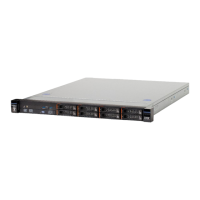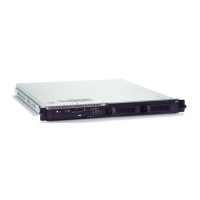– wwwww is the DIMM bandwidth, in MBps
- 8500 = 8.53 GBps (PC3-1066 SDRAMs, 8-byte primary data bus)
- 10600 = 10.66 GBps (PC3-1333 SDRAMs, 8-byte primary data bus)
- 12800 = 12.8 GBps (PC3-1600 SDRAMs, 8-byte primary data bus)
– m is the DIMM type
- E = Unbuffered DIMM (UDIMM) with ECC (x72-bit module data bus)
- R = Registered DIMM (RDIMM)
- U = Unbuffered DIMM with no ECC (x64-bit primary data bus)
– aa is the CAS latency, in clocks at maximum operating frequency
– bb is the JEDEC SPD Revision Encoding and Additions level
– cc is the reference design file for the design of the DIMM
– d is the revision number of the reference design of the DIMM
Note: To determine the type of a DIMM, see the label on the DIMM. The
information on the label is in the format xxxxx nRxxx PC3-xxxxx-xx-xx-xxx. The
numeral in the sixth numerical position indicates whether the DIMM is
single-rank (n=1) or dual-rank (n=2).
Unbuffered DIMMs (UDIMMs)
The following notes provide information that you must consider when you install
UDIMMs:
v The memory channels run at the lowest common frequency of the DIMMs
installed.
v The UDIMM options that are available for the server are 1 GB, 2 GB, 4 GB, and
8 GB (when available) DIMMs.
v The server supports up to two single-rank or dual-rank UDIMMs per channel.
The following table lists the supported UDIMM population.
Table 3. Supported UDIMM population per channel
DIMM
connectors per
channel
DIMMs
installed in each
channel DIMM type DIMM speed
Ranks per
DIMM (any
combination)
2 1 Unbuffered
DDR3 ECC
1333, 1600 Single-rank,
dual-rank
2 2 Unbuffered
DDR3 ECC
1333, 1600 Single-rank,
dual-rank
The following table lists the maximum DIMM population using ranked UDIMMs.
Table 4. Maximum memory population using ranked UDIMMs (depending on your model)
Number of
UDIMMs DIMM type Size Total memory
4 Single-rank UDIMMs 1 GB 4 GB
4 Dual-rank UDIMMs 2 GB 8 GB
4 Dual-rank UDIMMs 4 GB 16 GB
4 Dual-rank UDIMMs 8 GB (when
available)
32 GB
Chapter 2. Installing optional devices 45
